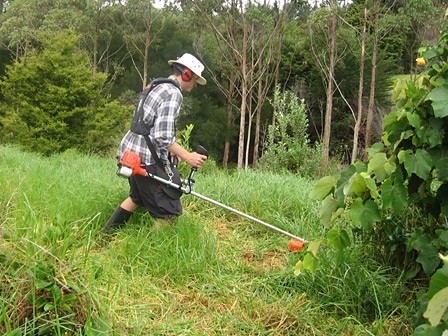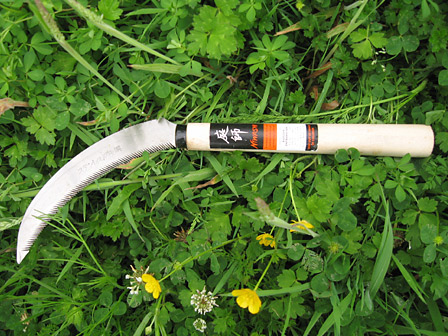Out of the five acres of land that makes up the Farmlet, only about three square meters of it had friable topsoil that was clear of kikuyu grass. In other words, only about three square meters of our five acre property was immediately suitable for gardening. Even though we have only been on this property for less than a year, we’re now harvesting vegetables—and have lots more growing—in our large, organic garden.
How did we get up and running so quickly?
Gas powered machines and sheet mulching.
Becky and I are not only focussed on using organic methods, we are paying close attention to the off-site inputs that we are using. We are especially concerned with energy and the use of non-renewable fuels.
Organic gardening isn’t a big mystery to us. We’re both experienced gardeners, so we know that organic gardening works. But what about organic gardening without petrochemical pack animals and field workers?
If you have ever tried to improve soil structure by adding organic matter, you know that it’s hard, time consuming work. We knew, from the very start, that we needed to amend our clay soil with a lot of organic matter. And we needed to do that immediately.
We decided to invest some of the little money we had in machines that, while not at all viable in the longterm, buy us time.
We are using these machines to, quite literally, build topsoil in a timely manner.
Our pickup truck has allowed us to bring in several cubic meters of organic matter from other locations. Look at this beautiful load of chipped tree branches from Becky’s parents’ house, for example.

1990 Nissan Navara, our pack animal, with load of mulch
We drove that stuff about 15km from the coast out to our property. How were the branches cut from the trees? With a gas powered chainsaw. How were they transformed into the smaller chips you see? A frightening and deafening chipper, attached to the back of a large diesel powered tractor, ate the branches and spit out the mulch into a neat pile.
Will this mulch eventually make nice topsoil, after we compost it with animal manure and let it age? Yes, for sure.
Is this path to improving soil sustainable? No.
Let’s look at another technique that we’re using to improve our soil. We’re composting a massive amount of random biomass (weeds) that we’re ‘harvesting’ from the house paddock.
But how are we ‘harvesting’ all of that stuff?
This Echo SRM-250 brushcutter is about as sustainable as the pickup truck and tractor/chipper rig. The Echo goes through heavily weeded areas like a hot knife through butter. It turns the heaviest kikuyu grass into coleslaw. Privet saplings, no problem. Thick sedges, zip.

Full throttle with the Echo SRM-250, tri-blade brushcutter
Here’s a tool that can accomplish roughly the same task in a sustainable manner.

Niwashi Garden Shark, toothed sickle
I did try out the Niwashi. Yep. It works. And I can assure you that you wouldn’t want to clear a large patch of weeds for composting with this tool, unless you had too. We will use the Niwashi for small jobs, especially areas around trees, but the Echo does the ‘heavy lifting’ for the moment.
While we considered buying a full sized scythe, four factors dissuaded us:
- Using a scythe is extremely hard, physical work
- It takes years of practice to learn how to use a scythe properly
- A modern scythe is not an inexpensive tool, costing roughly half what that Echo brushcutter costs
- Grass/weed cutting in not part of our long term plans, but is required initially
It’s difficult to express how much work gas powered machines can do, compared with trying to do the same work by hand. It’s shocking, actually. The goal, therefore, is to build permaculture systems that greatly reduce the human labor required and eliminate off-site energy inputs.
Let’s look at a passage from Bill Mollison’s Introduction to Permaculture:
In a permaculture system, we use biological resources (plants and animals) wherever possible to save energy and do the work of the farm. Plants and animals are used to provide fuel, fertiliser, tillage, insect control, weed control, nutrient recycling, habitat enhancement, soil aeration, fire control, erosion control, and so on.
Building up biological resources on site is a long-term investment which needs thought and management in the planning stages as it is a key strategy for recycling energy and developing sustainable systems. We use green manures and leguminous trees instead of nitrogen fertiliser; weeder geese and short herbs rather than lawn mowers; biological insect control rather than pesticides; and animals such as chickens or pigs instead of rotary hoes, weedicides, and artificial fertilisers.
However, careful and appropriate use of non-biological resources (fossil-fuel-based machinery, artificial fertilizers, technical equipment) in the beginning phases of permaculture is OK if they are used to create long-term, sustainable biological systems and an enduring physical infrastructure.
…
By all means carefully use what is available, use it for the best possible reasons, and develop alternatives as fast as possible.
We find that it always helps to keep the above passage in mind with everything we do on the Farmlet.
There is definitely an inertia factor in play at the beginning, as Mollison mentions. Getting up to speed is hard. If using gas powered tools will allow you to get initial control over small areas, so that you can establish your garden, animal and composting systems, use them.
If you can’t afford the machines, or refuse to use them, the goals are attainable, but with much more effort and on a much longer time scale. This principal should be kept in mind by those who think permaculture will spring up, like a rabbit out of a magician’s hat, as we move into collapse. Sorry. It’s not going to happen that way. But enough about that.
The importance of sheet mulching can’t be understated. Please learn this simple technique and be ready to teach it to others. We used this technique in solid kikuyu, one of the most invasive grasses on the planet, and we are growing beautiful vegetables in those areas now. We used no herbicides (or synthetic chemicals) of any kind. Animal manure and composed plant matter and woodchips (like in the picture above) were added to our soil. That’s it. (We are going to put chickens to work on the next phase of the garden.)
The combination of sheet mulching with limited use of gas powered machinery has served us well. These tools have allowed us to start a sizable, thriving garden, full of tasty vegetables, in less than a year. And it’s just going to get better with time!


